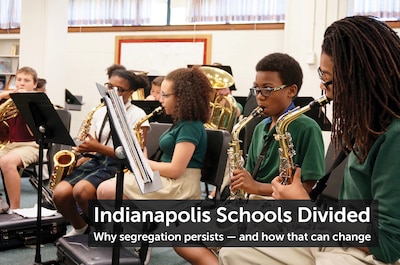The state’s largest school district is moving forward with a plan to help diversify its coveted magnet schools that could give low-income applicants a leg up in the admissions lottery.
But attracting new families is an ambitious and challenging goal, and experts say success will depend on the commitment and investment from the district.
The vast majority of students in Indianapolis Public Schools are black or Hispanic and nearly seven in 10 are low-income. But at a handful of the district’s most sought-after magnet schools, the demographics don’t reflect the district as a whole. The schools, which offer admissions priority to students who live in well-to-do neighborhoods where they’re located, enroll many more affluent, white students.
It’s an inequality that was identified in a series on school segregation in Indianapolis from Chalkbeat, the Indianapolis Star and WFYI. The series exposed the role admission lottery rules play in exacerbating the isolation of the district’s magnets.
IPS leaders say they are committed to solving the problem and they plan to discuss ways to admit more diverse populations to the district’s popular magnets at a school board meeting this month.
Experts say that the district will need to do more than modify lottery rules to attract diverse students. It will also need to ramp up recruitment and retention work among low-income families.
“This is bigger than … a school district magnet lottery,” said Claire Smrekar, a researcher who has been studying magnet schools for more than 25 years. “It’s about neighborhood context.”

The district’s current magnet school admissions rules prioritize students who live within about a mile of certain schools such as the Centers for Inquiry, Montessori schools and the Butler Lab program at School 60. Those schools typically have long waitlists and award spots by lottery, and since many of the schools are located in higher-income areas, the rules make it harder for students from lower-income neighborhoods to score seats.
School board members appear to have reached a consensus that the best way to address the edge given to higher-income kids is to shrink the priority boundaries surrounding the schools.
“I really support sort of looking at shrinking those proximity boundaries,” said board member Kelly Bentley. That, she said, will “allow for more families outside of that boundary to have an opportunity to go to the school.”
Board president Mary Ann Sullivan also asked the administration to consider a strategy that would go a step further by setting aside seats specifically for low-income students at the schools. She said she may support setting aside seats if it’s necessary to promote diversity.
The district could have even more control over the demographics at schools by targeting certain neighborhoods for recruitment and using census data to set lottery priority based on each student’s address, Smrekar said. (Even if the district’s goal is increasing racial diversity in schools, explicitly using race as a factor in the lottery is illegal.)
The board aims to change the admission rules as early as this fall.
But while lottery rules that seem to favor more privileged families have ignited impassioned criticism in the community, experts say they are just a small piece of the puzzle when it comes to diversifying magnet schools.
Smrekar, who is a professor at Vanderbilt University and has consulted for the civil rights division of the U.S. Department of Justice, said that changes in admission policies must also be paired with a clear strategy for ensuring that low-income and black and Hispanic families know about their magnet school options, apply for admission and stay in the schools once they enroll.
One of the most important ways of recruiting families is doing outreach in their communities instead of expecting them to come to the district for information, she said. That means taking steps like hosting meetings at places where families are comfortable, such as churches, workplaces and community centers.
The people reaching out to prospective families can be central office staff, teachers or community members hired specifically for recruitment, Smrekar said. They just need to be good at communicating with families about what the magnet schools can offer their children.
“The geography of opportunity for a lot of these families is quite limited because of income and transportation and language,” she said. “(It) requires a larger effort by the school district to penetrate that and to appear both trustworthy … and committed to these goals of increasing diversity.”
The board has asked the administration to come up with a plan for marketing that would be rolled out alongside changes to lottery rules.
Superintendent Lewis Ferebee is supportive of some changes aimed at diversifying the schools, including increasing recruitment efforts and modifying the lottery rules. But he also said it is “odd” to expect magnet schools to be more diverse than the neighborhoods where they are located.
“There’s things that we can do, but I still believe that our schools reflect their neighborhoods and the community by and large.” Ferebee said. “My focus is ensuring that there’s a quality school in every neighborhood.”
Even if the district and schools are able to attract more diverse students, maintaining diversity is a constant balancing act for schools, Smrekar said.
Parents who chose their schools because of the International Baccalaureate or Montessori magnet programs may have legitimate fears that the influx of new families who were actively recruited are not as dedicated to the model, she said. Research also shows that white families are reluctant to keep their students in schools that are majority black or Hispanic.
Keeping new students at the schools can also be a challenge, she said. Schools have to work to create a welcoming climate for their families and build relationships with their parents.
“It’s one thing to reach out, but it’s another thing to maintain that enrollment and retention,” Smrekar said. “Does the district have the commitment and the capacity to move through this process from community engagement to retaining and keeping these families?”
Correction: This story has been updated to reflect the fact that IPS board president Mary Ann Sullivan has not yet decided whether to support setting aside seats for low-income students.

